Amy Sue Nathan's Blog: Women's Fiction Writers, page 15
June 29, 2016
Guest Post: Writing Around Your Dialogue by Author Katie Rose Guest Pryal
Today we’re talking about dialogue (HA) here on WFW with my fellow Tall Poppy Writer Katie Rose Guest Pryal. We all love to read great dialogue, and though we all write differently, there are pitfalls we can all avoid! Here’s how Katie tackles the dialogue in her novels!
Remember, when it comes to writing advice, please take what what you need and leave the rest.
Welcome Katie to WFW and leave your dialogue tips in the comments!
Amy xo

Framing Text: How To Write Well Around Your Dialogue
by Katie Rose Guest Pryal
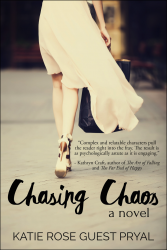 Many authors lament writing dialogue. So many things about dialogue seem too challenging:
Many authors lament writing dialogue. So many things about dialogue seem too challenging:
Making it sound how real people talk
Conveying character through snippets of speech
Making sure each character sounds unique
Conveying action while people are talking
Ensuring that a reader understands who is speaking during a conversation
and more.
I’m very lucky. On a whim, in college, I took a screenwriting class. That class was the best thing to ever happen to my fiction. I learned how to write dialogue, dialogue that conveyed unique character traits, action, realism, and all of the other things that make writing dialogue so difficult. After all, a screenplay consists almost 100% of dialogue. If your dialogue sucks, your screenplay sucks.
I’m not saying I write the greatest dialogue. I’m only saying that the screenwriting class gave me confidence to try to tell stories through conversation. And as most writers know, confidence goes a long, long way.
But, in the short space I have here, I’m not going to talk about writing dialogue. I’m going to talk about the writing that goes around your dialogue.
Framing Your Dialogue
The writing that goes on around your dialogue, what I (and likely others) call the “framing” text, is arguably as important as the dialogue itself. But many writers give it short shrift.
Framing text never appeared in my screenplays, and I had to study really hard to learn to write it well when I made the leap from scripts to novels.
The most common framing text consists of a noun or pronoun plus the word “said,” like this:
“Dialogue,” she said.
But there are problems with using “said” to frame all of our dialogue. First, it’s really boring. You are basically using the same word over and over again, and the repetition gets old. Second, and worse, you are wasting opportunities. Instead of “said,” you could be using that framing text to convey what the speaker is doing or thinking.
Your framing text can also make sure your reader knows who is talking to whom, how your speaker feels about what is being said, and what else is going on during the conversation. If you limit yourself to the word “said,” then you aren’t giving yourself enough room to do all those things that need doing.
This isn’t to say that you shouldn’t ever use the word “said” in your writing. You can, and should, most certainly. But challenge yourself to write entire scenes without it. See what happens. Only resort to “said” if you have to.
An Example of Dialogue Framing Text without “Said”
Here’s a sample scene from a novel I’m working on now, the sequel to Chasing Chaos (which just came out in June). The only setup I’m going to give you is this: two characters, Miranda and Sandy, have just entered an exclusive Los Angeles restaurant. The rest—setting, characterization—you’ll have to get from the dialogue and its framing text. I’ll interject in brackets to point things out.
[begin scene]
The host approached them, a young man, certainly younger than Miranda’s twenty-eight years. He was in his early twenties, perhaps his late teens. His dark suit was well tailored, though, and well made.
[The above paragraph should alert you that we are in Miranda’s point of view.]
“Jonas.” Sandy greeted the host, then he nodded at Miranda. “This is Miranda George, an old friend of Greta Donovan and Daphne Saito. She just moved to L.A. Been here about a week.”
[Notice how Sandy’s framing text does not use the word “said.” The framing text also conveys the physical gestures that Sandy makes so we can picture what he’s doing, e.g., nodding.]
Miranda thought it was a stretch to call her an “old friend” of either Daphne or Greta, but she wasn’t going to correct Sandy.
“It’s great to meet you, Miss George.” Jonas smiled, revealing either the most lucky dental genetics ever, or at least ten grand in orthodontia.
[Again, the word “said” isn’t used to indicate Jonas’s speech. This framing text was also an opportunity to reveal more about Miranda’s character. You will see that she is a bit snarky.]
She figured it was the latter. “Please just call me Miranda.”
“That’s what Mr. Sandy always says.” Jonas flushed a deep scarlet. “I mean, Sandy.”
[Here if we haven’t figured out that Jonas is very young, goofy, and adorable, then I basically need to give him pimples.]
“It’s all right, Jonas.” Sandy smiled kindly. “Our table ready?”
Miranda was certain that Sandy’s table was always ready, considering he owned not only the restaurant but also two Academy Awards for Best Actor.
[In the framing text of the above two paragraphs, we learned two things. One, Sandy is a nice guy, and two, Sandy is rich as hell.]
Jonas grabbed two thick leather menus from a stand by the door. “Follow me, sir.”
“After you.” Sandy held out his hand for Miranda to take the lead. When she didn’t step forward immediately, he chuckled. “Don’t like having people at your back?”
[Here, Sandy is showing a little snark of his own. It makes us like him better.]
“It’s fun to follow you. I get to watch idiots trip over themselves when they see who you are.”
Sandy paused, looking at her thoughtfully. “You don’t think highly of other people.”
[Aha. Sandy is insightful. This insight has an effect on Miranda in 3, 2, 1…]
“I’m selective.” As a rule, Miranda indeed didn’t think highly of other people. But she wasn’t going to tell Sandy that. Her misanthropy was not her most charming feature.
[And here we have insight into Miranda. She’s snarky but also cares what Sandy thinks of her. Interesting.]
“Where do I fall?” Sandy surprised her by sounding genuinely curious, even concerned.
[Sandy cares what Miranda thinks? But why? Don’t you totally want to keep reading?]
She smiled, trying to lighten a conversation that had grown darker than she’d planned it to. “I’ll let you know after I’ve bought you a drink.”
“You’re buying?” He sounded surprised. Good.
“In a manner of speaking.” Miranda still had the credit card she’d taken from her mother’s wallet.
Sandy laughed. “After me, then.”
[end scene]
As you can see from this brief demonstration, the language that you put around your dialogue can be just as important as the language that you put in your dialogue. It can convey scene, character, plot (what’s up with that stolen credit card?), and more. Be sure you give it as much thought as it deserves.
 Katie Rose Guest Pryal, J.D., Ph.D., is a novelist, freelance journalist, and erstwhile law professor in Chapel Hill, NC. She is the author of the Entanglement Series, which includes ENTANGLEMENT, LOVE AND ENTROPY, and CHASING CHAOS, all from Velvet Morning Press. As a journalist, Katie contributes regularly to QUARTZ, THE CHRONICLE OF HIGHER EDUCATION, THE (late, lamented) TOAST, DAME MAGAZINE, and more. She earned her master’s degree in creative writing from the Writing Seminars at Johns Hopkins, where she attended on a fellowship. Currently, she is teaching creative writing through Duke University’s Osher Lifelong Learning Institute, working as a writing coach and editor, and writing her next novels.
Katie Rose Guest Pryal, J.D., Ph.D., is a novelist, freelance journalist, and erstwhile law professor in Chapel Hill, NC. She is the author of the Entanglement Series, which includes ENTANGLEMENT, LOVE AND ENTROPY, and CHASING CHAOS, all from Velvet Morning Press. As a journalist, Katie contributes regularly to QUARTZ, THE CHRONICLE OF HIGHER EDUCATION, THE (late, lamented) TOAST, DAME MAGAZINE, and more. She earned her master’s degree in creative writing from the Writing Seminars at Johns Hopkins, where she attended on a fellowship. Currently, she is teaching creative writing through Duke University’s Osher Lifelong Learning Institute, working as a writing coach and editor, and writing her next novels.
web: http://katieroseguestpryal.com
books: http://amzn.to/1XFCLYS
twitter: http://twitter.com/krgpryal

June 28, 2016
Summer Fun Giveaway!
Beach, pool, mountain, lake, air-conditioned living room. Doesn’t matter where you do your summer reading! How about adding The Good Neighbor (a signed copy no less) to your To-Be-Read pile? Already crossed it off your to-read list? Enter to give as a gift. Can you say Christmas-gifts-in-July?
Just click the Goodreads link to enter. That’s the only way. No comment on this blog gives you a chance to win, sorry.
Good luck!
Amy xo
Goodreads Book Giveaway
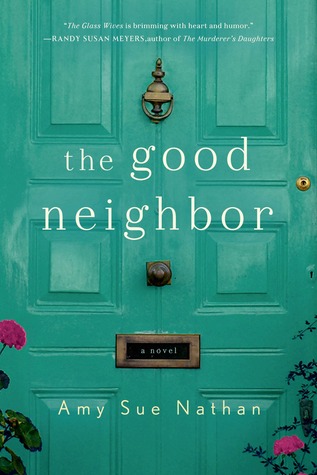
The Good Neighbor
by Amy Sue Nathan
Giveaway ends July 07, 2016.
See the giveaway details
at Goodreads.
June 26, 2016
The Writing Life #12

This week, in the writing life, I was thinking about what happens when a story ends, and I thought about it in a few ways (of course I did).
I’ve had people ask where my character are now. What do I envision them doing? Did Evie and Sandy from The Glass Wives end up together (most readers say yes). What happened to Nicole? From The Good Neighbor readers ask if Izzy ever had any more children (she’d wanted a busload) or if Rachel and Seth ended up okay.
My answer is always tentative, and soft. I’m not sure if I should be embarrassed. The truth is, my characters live on the last page of their novels in perpetuity. For me, Evie and her friends and family are still cleaning up from the Passover Seder and Izzy sits forever on the front steps of her childhood home on Good Street, ready, at last, to walk away and start anew—but in my mind—she still right there.
My characters and stories have no afterlife for me.
The same goes for my short stories, though, as I’ve mentioned before, some of those have helped to inspire portions or characters in my novels. Instead of those stories moving forward perhaps, they exist as a well of possibilities. Their futures lie in my own future work. In The Apron Strings of Amber Sweetly, the ending of the story was a direct inspiration for the ending of The Good Neighbor. I had struggled with the ending for that novel, and then the words sprung to mind, and I knew that I had already written the template for what would work perfectly. In The Kindness of Neighbors, there’s a feisty lady in her eighties. She doesn’t ring true for Mrs. Feldman in The Good Neighbor, but in her I see bits and pieces of Boop from my WIP. None of that was intentional, but as I reread that story today it reminded me, it showed me, that indeed there must be something to it, if it keeps popping up. Which means Boop will prevail. I knew she would.
I think what this means to me is that perhaps there are nuggets in whatever we write that might be plucked out and focused on in their entirety. I don’t mean writing a series or a sequel (not for me, anyway) but taking some old idea and making it new, turning it inside out and upside down. If it was good enough for a mention in one book, maybe there’s more to it. Maybe not, but maybe. And that’s a good enough reason, perhaps, to revisit some old work.
That’s what I did yesterday. I reread The Apron Strings of Amber Sweetly and The Kindness of Neighbors, both which had been published in literary journals that no longer exist. And I liked them both. Apron Strings remains my favorite short story of mine to this day, and I’d written about had about six published. I remembered that I’d written “Apron Strings” as a way to experiment with first person present tense. I’d been writing fiction in third person as a way to differentiate it from my essay writing. Then, I read Henry’s Sisters by Cathy Lamb (have you not read Henry’s Sisters? You should) and it was in first person. I’d read many first-person POV novels but none to that point that were as captivating as this one. None struck a chord or made me think “I want to do that,” until Henry’s Sisters. In “Apron Strings” I stretched my writing wings, and while I have never switched from past tense to present tense in my novels, I have shifted to first person from third. I don’t know if I’d have been that brave without reading Cathy’s book. Thanks, Cathy!
When I reread The Kindness of Neighbors, I remembered it had won a coveted short story contest and had been published in The Grey Sparrow Journal both in print and online. 2011 seems like a lifetime ago — I hadn’t sold my first novel yet — so these publishing coups meant the world to me. And still do. I also remembered that the sense of home and a newfound family and purpose also resonated through The Good Neighbor.
If you’re interested, you can read The Apron Strings of Amber Sweetly and The Kindness of Neighbors.
***
Here’s a lovely new review of The Good Neighbor. It’s so nice to find something like this eight months after the book came out. I know the book is selling, but feedback is a wonderful thing.
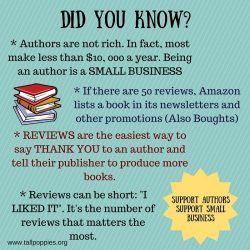
***
This week in real life, Mitzi jumped on the bed after about six months of not jumping up on the bed due to knee and hip issues (she’s 12). Then she proceeded to roll all over it on her back, the way dogs do, making sure that no spot was left unacknowledged. She was very grateful I’d been keeping her bed warm for her. But last night, she slept on the floor as usual, so it might have been too much excitement, even for her.
Also this week in real life, I had my two kids home at the same. BANNER WEEKEND for mom. This will happen again at the end of August. Then again at Thanksgiving, wherever that Thanksgiving may be.
But that’s another story…
Amy xo
June 19, 2016
The Writing Life #11

A Stitch In Time
This week, in the writing life, I started a project (okay, maybe two) that have nothing to do with writing. For a few years I was painting furniture, collecting bits and pieces from Salvation Army and salvaging them. But in an effort to have less, not more, I stopped adding things to the house. There went the hobby.
But then my daughter cam home for the summer, and she pulled out her sewing machine, asked for craft supplies (she’ll be 21 in 6 weeks) and when she’s not working has been hold up in her room creating things of her own from clay animals to fabric pouches and other creations.
She pulled out a small cross stitch kit I’d given her years ago for Hanukkah, and asked me to show her how to do it. I wanted to show her a finished project so I headed right for the top bookshelf in my family room where a small pillow I’d made for my grandmother has sat for past eleven years, since she died. It’s such a good feeling to know exactly what you need to make a moment meaningful.
It wasn’t there. Of course it wasn’t. I’ve packed up most of my personal stuff in preparation for an eventual move.
Sigh.
So I sat down next to her and showed her how to find the center of the Aida cloth, how to count the squares, how to stitch each x. I spent my twenties cross-stitching. Perhaps she would as well.
Or, she could hate it.
But I remembered how much I liked it!
Off we went to the craft store again.
And that night I watched TV without the appendage of an iPhone but with that of an embroidery needle. It has been good to take a break from any and all things editing and writing related. I don’t usually want to do that, you see. When I picture a wonderful day, more than not, it includes a notebook or my laptop. But it’s good to let the mind rest (ask anyone who knows me well, it’s not something that happens often), and to create in a new (old) way.
How would you fill the jar?

Books And Such
Did you know Reader’s Digest Condensed Books was a thing? Or still a thing? Apparently it was very popular in the 1950s, and was revived some years back and is going strong. THE GOOD NEIGHBOR was included in the May edition of Reader’s Digest Select Editions. I haven’t seen a copy in person, but snagged this fabulous photo from Facebook. I haven’t read the other books but the cover is perfect for The Good Neighbor, don’t you think? Makes me want to curl up and read it all over again.
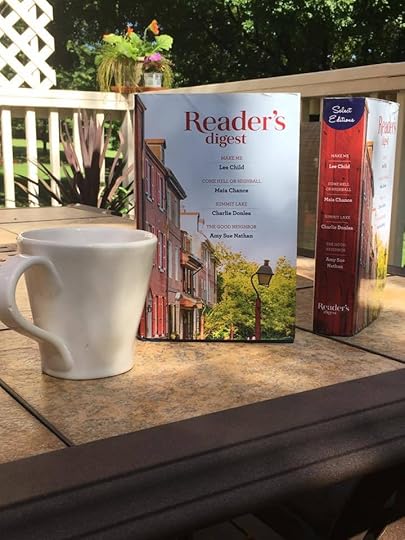
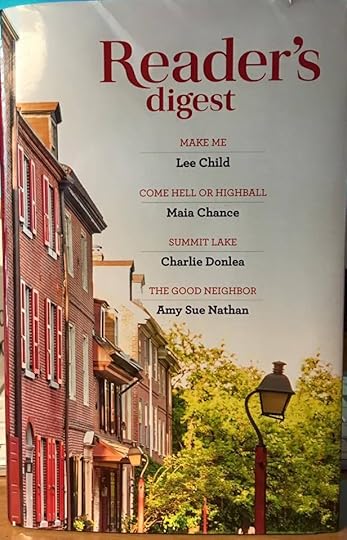
Also this week, author Laura Nicole Diamond featured me in the Writer’s Life section of her blog, so of course I’d share that here in my Writing Life post! You can read that interview here. In it I explain why this has been my personal mantra for decades, and will continue to be.

One of my favorite parts of this week was meeting Beth Havey, fellow WFWA member, for the first time. Beth is a loyal WFW reader, so let’s all wave to Beth! HI BETH! We met at a charming restaurant in the town where I live, where, it just so happens, Beth used to live. Meeting writer friends has to be one of my favorite parts of the writing life. Let’s all send Beth some query-juju as she’s on the quest for a literary agent!

Editing Woes
The only thing I don’t like about freelance editing is that I often have to prioritize it over my own editing. The deadlines for freelance are immediate, and someone is counting on me for feedback, whereas my own deadline is farther away. I also approach this work differently. I freelance edit by the page, meaning, I read a portion of the submission, and then edit it, and move forward. I can choose to do ten, twenty, thirty, or fifty pages in a sitting, then I move onto another freelance project, or other work.
When it comes to Left To Chance, I have to set aside a day. Yes, a whole day, or at least half a day. Because once my brain train leaves for that destination there is no jumping off to see the sights, I’m on it until the end of the line.
Oh, the travel metaphors!
I guess metaphor will meet life when I head back to South Haven, Michigan to conduct more research for book #4. You remember Boop and Hannah, don’t you? That’s where their story unfolds. I’m just hoping this time to get a little sunshine! (In the 60s and windy on the lake means cold. My friend stayed in the car while I took pictures!

In honor of Father’s Day, here’s a look back! Happy Father’s Day, Dad!
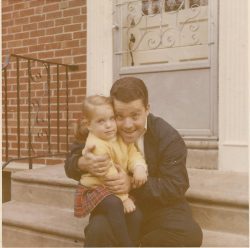
And in a look forward, this week I’ll see both of my kids AT THE SAME TIME, finish up a few freelance manuscripts, and I have two full days set aside for my own writing life. (Fingers crossed on that one!)
Amy xo
June 13, 2016
Guest Post: Author Ann Garvin’s (Very Personal) Inspiration For Her New Novel
I could talk about Ann Garvin all day—in the good way. I’m thrilled to have her here on Women’s Fiction Writers today sharing her inspiration and the motivation for her third novel I Like You Just Fine When You’re Not Around.
Here’s my take on the book, but you should really read it for yourself.
In I LIKE YOU JUST FINE WHEN YOU’RE NOT AROUND, Ann Garvin skillfully weaves an intricate tale of life and love that allows the reader to easily immerse herself in a complex family dynamic. The cast of characters is realistic as well as delightfully quirky, and Garvin’s sharp wit and keen insight shine through on every page. I LIKE YOU JUST FINE WHEN YOU’RE NOT AROUND is a heartwarming and humorous read.
Please welcome Ann Garvin to WFW!
Amy xo

I Like You Just Fine When You’re Not Around
(and how writing this helped me figure out life)
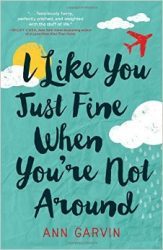 Be honest. This reminds you of someone. You read the title of this new book, and laugh a little and then a face materializes in your mind.
Be honest. This reminds you of someone. You read the title of this new book, and laugh a little and then a face materializes in your mind.
You think of the time you went on a road trip with your sister. The one that makes you giggle but also drinks too much at night and starts telling strangers your secrets.
Or,
It’s your husband that comes to mind. The one you promised to cherish and honor all those years ago. The father of your children. The one who hovers over your shoulder when you pay the bills and asks,
“What was that one for?”
Maybe he’s retired and can’t quite figure out what to do with himself and you just want to be in the alone in the house.
It could be your friend who can’t stop talking about how brilliant her kids are. How good they are at soccer, math, or college applications. She’s your best friend and you want her to stop talking.
We love our people. We love our family but sometimes, just sometimes we’d like them to go away.
But, then what happens when they do go away, those people that we love? What happens if they decide to leave us, or lose their memory of us, or they escape out of stress or frustration? What happens when we say,
“Just kidding! I love you. Please stay!” But, they can’t hear you.
That’s when we start to learn things. That’s when we laugh at ourselves and begin to figure out how to love. Really love. Love ourselves enough to ask for space. Love our people enough to recognize their flaws. Love our partners even when we wish they’d just shut the hell up and let you watch Netflix in peace.
I didn’t realize that this was what my book was about until I wrote it. I knew I wanted to write about a therapist who was not very good with her personal relationships. I knew that she was going to try and work it out on a radio show but I didn’t know it was about the complexity of the love and hate in relationships until I wrote the whole book. Writing is like that some times; like novel-length personal therapy. Like figuring life out as you go along. Just like actual life, but with made up characters.
And, so, that’s what I Like You Just Fine When You’re Not Around is about. It’s about how one woman tries to figure out what’s fair in relationships. It’s when she decides that she’s not going to passively accept everything just because. It’s when she starts to be more active in her life and sometimes she get’s it right and sometimes not.
Just like me.
Just like you.
It should make you laugh, see yourself, and maybe just feel a little better about life in general. And it won’t tell even one of your secrets after you whisper them into the pages.
 Dr. Ann Garvin, is an author, speaker and professor of exercise physiology, psychology, nutrition, and health. Her novels I Like You Just Fine When You’re Not Around, The Dog Year, & On Maggie’s Watch are each about women who struggle to find their way in a world that asks too much from them, too often. Garvin balances her literary pursuits with teaching in WI And NH while supporting other women writers and raising a family. She is the founder of the Tall Poppy Writers and The Fifth Semester.
Dr. Ann Garvin, is an author, speaker and professor of exercise physiology, psychology, nutrition, and health. Her novels I Like You Just Fine When You’re Not Around, The Dog Year, & On Maggie’s Watch are each about women who struggle to find their way in a world that asks too much from them, too often. Garvin balances her literary pursuits with teaching in WI And NH while supporting other women writers and raising a family. She is the founder of the Tall Poppy Writers and The Fifth Semester.
Guest Post: Author Ann Garvin
I could talk about Ann Garvin all day—in the good way. I’m thrilled to have her here on Women’s Fiction Writers today sharing her inspiration and the motivation for her third novel I Like You Just Fine When You’re Not Around.
Here’s my take on the book, but you should really read it for yourself.
In I LIKE YOU JUST FINE WHEN YOU’RE NOT AROUND, Ann Garvin skillfully weaves an intricate tale of life and love that allows the reader to easily immerse herself in a complex family dynamic. The cast of characters is realistic as well as delightfully quirky, and Garvin’s sharp wit and keen insight shine through on every page. I LIKE YOU JUST FINE WHEN YOU’RE NOT AROUND is a heartwarming and humorous read.
Please welcome Ann Garvin to WFW!
Amy xo

I Like You Just Fine When You’re Not Around
(and how writing this helped me figure out life)
 Be honest. This reminds you of someone. You read the title of this new book, and laugh a little and then a face materializes in your mind.
Be honest. This reminds you of someone. You read the title of this new book, and laugh a little and then a face materializes in your mind.
You think of the time you went on a road trip with your sister. The one that makes you giggle but also drinks too much at night and starts telling strangers your secrets.
Or,
It’s your husband that comes to mind. The one you promised to cherish and honor all those years ago. The father of your children. The one who hovers over your shoulder when you pay the bills and asks,
“What was that one for?”
Maybe he’s retired and can’t quite figure out what to do with himself and you just want to be in the alone in the house.
It could be your friend who can’t stop talking about how brilliant her kids are. How good they are at soccer, math, or college applications. She’s your best friend and you want her to stop talking.
We love our people. We love our family but sometimes, just sometimes we’d like them to go away.
But, then what happens when they do go away, those people that we love? What happens if they decide to leave us, or lose their memory of us, or they escape out of stress or frustration? What happens when we say,
“Just kidding! I love you. Please stay!” But, they can’t hear you.
That’s when we start to learn things. That’s when we laugh at ourselves and begin to figure out how to love. Really love. Love ourselves enough to ask for space. Love our people enough to recognize their flaws. Love our partners even when we wish they’d just shut the hell up and let you watch Netflix in peace.
I didn’t realize that this was what my book was about until I wrote it. I knew I wanted to write about a therapist who was not very good with her personal relationships. I knew that she was going to try and work it out on a radio show but I didn’t know it was about the complexity of the love and hate in relationships until I wrote the whole book. Writing is like that some times; like novel-length personal therapy. Like figuring life out as you go along. Just like actual life, but with made up characters.
And, so, that’s what I Like You Just Fine When You’re Not Around is about. It’s about how one woman tries to figure out what’s fair in relationships. It’s when she decides that she’s not going to passively accept everything just because. It’s when she starts to be more active in her life and sometimes she get’s it right and sometimes not.
Just like me.
Just like you.
It should make you laugh, see yourself, and maybe just feel a little better about life in general. And it won’t tell even one of your secrets after you whisper them into the pages.
 Dr. Ann Garvin, is an author, speaker and professor of exercise physiology, psychology, nutrition, and health. Her novels I Like You Just Fine When You’re Not Around, The Dog Year, & On Maggie’s Watch are each about women who struggle to find their way in a world that asks too much from them, too often. Garvin balances her literary pursuits with teaching in WI And NH while supporting other women writers and raising a family. She is the founder of the Tall Poppy Writers and The Fifth Semester.
Dr. Ann Garvin, is an author, speaker and professor of exercise physiology, psychology, nutrition, and health. Her novels I Like You Just Fine When You’re Not Around, The Dog Year, & On Maggie’s Watch are each about women who struggle to find their way in a world that asks too much from them, too often. Garvin balances her literary pursuits with teaching in WI And NH while supporting other women writers and raising a family. She is the founder of the Tall Poppy Writers and The Fifth Semester.
June 8, 2016
Guest Post: How Amy Impellizzeri Became A Published Author
I wish I could tell you there was a secret sauce or magic words that would help you sign with an agent and lead you to publishing a novel. Truth is, it all feels that way sometimes, since there are so many roads for everyone, including authors who are seeking literary representation and a traditional, legacy publisher.
Today my friend Amy Impellizzeri shares with us what she did, and didn’t do, to become a published, agented author.
Why not share YOUR author story in the comments and welcome Amy to WFW!
Amy xo
What I Did (And Didn’t Do) To Become a Published, Agented Author
by Amy Impellizzeri
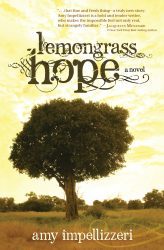 Exactly 7 years ago this month, I did something so crazy, so unreasonable, so wonderful. I walked away from my 13+ corporate law career and became a writer.
Exactly 7 years ago this month, I did something so crazy, so unreasonable, so wonderful. I walked away from my 13+ corporate law career and became a writer.
What I didn’t do: Walk away from my day job with no plan in place. Also something I didn’t do: Ever again replace my corporate law salary.
What I did: Something so much better.
When I left corporate law, I had some savings and I hustled for freelance writing for a full year. I worked and researched (and volunteered!) for a prominent advocacy group, which led to an invitation to write a piece that was picked up by The Huffington Post. I also started an online column in New York, wrote for various journals, and freelanced for a virtual magazine, Hybrid Mom (later re-named Hybrid Her.) My expanding writing portfolio helped bolster my confidence and my platform.
The freelance work for Hybrid Her turned into a full-time executive position within a year or so and I turned my attention away from freelance writing to working in earnest on a novel . I wrote that novel alongside my day job and my other gig as mother of three for several years.
In 2013, I finally finished my novel – LEMONGRASS HOPE – and decided to pursue publication.
What I didn’t do: Send it off to every agent I could think of.
What I did: Learned about the business of publishing and worked on polishing my manuscript.
Around the time I was finishing an early draft of my LEMONGRASS HOPE manuscript, I went to a writing workshop in Washington D.C. led by author, Sarah Pekkanen. I learned a great deal about the business of publishing at that time, including from Sarah herself who later read an excerpt of my novel and pushed me to pursue publication. “You are an amazing writer,” she wrote. Swoon.
I worked for months with a developmental editor who said something a little less swoon-y. “Your novel starts in the wrong place.” Thud. But she was right. I pulled the book apart, re-worked the beginning, and revised several more times before starting the submission process in late 2013.
What I didn’t do: Spend years waiting out rejection after rejection until my book got picked up.
What I did: Sent my manuscript directly to a reputable indie press that I had researched thoroughly.
2013 was a pivotal point in my writing career. While I was editing my LEMONGRASS HOPE manuscript in the local coffee shop, I received a call from an agent who worked extensively with the American Bar Association’s publishing arm. She had discovered my legal writing and other non-fiction pieces from my previous freelance career. “I want you to help me pitch a book to the ABA called LAWYER INTERRUPTED,” she said. I looked down at my pile of edits and said: “Sure! There’s just one little thing I need to finish first.”
The ABA actually green-lighted LAWYER INTERRUPTED in the fall of 2013, and with a deadline to finish a non-fiction book on contract, I was incentivized to get the novel I had been working on for years into print sooner rather than later. I knew all the stories of debut authors waiting years to get noticed. I knew the average number of query letters sent by an unknown author was approximately one million. Give or take. I started researching indie presses who accepted submissions without agent representation which led me to Nancy Cleary, founder of award-winning indie press, Wyatt-MacKenzie. A dear friend, and former NYC magazine editor had known Nancy for years, and recommended her highly. I had read several titles published as Wyatt-MacKenzie books or imprints and was impressed with Nancy’s reputation even though I knew her roster was largely filled with non-fiction authors, and very few debuts.
I sent a partial manuscript of my novel to Nancy and she asked for a phone call. She reminded me about her roster of largely non-fiction and very few debuts. I was pushy. I said “Would you mind – just read the whole thing?”
She relented. “Ok. We’ll talk next week.” By the next week I had a publishing contract for LAWYER INTERRUPTED AND LEMONGRASS HOPE. I looked at my prepared list of agents – the ones I was about to send the manuscript to before I met Nancy – and threw it away. I negotiated my own contract and I took a leap of faith. One that I never regretted. Wyatt-MacKenzie did a beautiful job with my debut novel, and together we got LEMONGRASS HOPE in some wonderful hands. Kirkus gave a great review, as did Forewords Magazine. There were awards and recognition and respectable debut sales numbers. While promoting LEMONGRASS HOPE, I finished my non-fiction book, Lawyer Interrupted – which was later released in 2015 – and immediately started work on a new novel.
What I didn’t do: Stop writing.
What I did: Submitted my second novel to a host of Women’s Fiction agents.
In late 2015, my second novel, SECRETS OF WORRY DOLLS was ready for submission. I started sending SECRETS out to agents along with a summary of the success of LEMONGRASS HOPE and LAWYER INTERRUPTED, hoping I would be harder to ignore than I would have been as a debut author. I received several immediate requests for partials and fulls, and while I was tempted to wait those out, a writer friend gave me some good advice – “leverage your success and the interest your manuscript is getting.” Every time I received a manuscript request, I sent out more queries, not less.
At one point, my manuscript was being reviewed by 10 different prominent agents, including Bob Diforio, my dream agent. When Bob told me he had “read enough to know that I want to represent you,” I advised the other agents reviewing my manuscript that I had found my match. I signed with Bob in late 2015, and we officially went out on submission with my newest manuscript a few months ago. I am headfirst into my third novel now – which actually incorporates some courtroom/legal scenes for the first time. I guess you’d call that a full circle moment in my writing career.
So here we are. It’s June 2016 and I am so grateful to be working on my third novel (my fourth book!) less than three years after selling LEMONGRASS HOPE to Wyatt-MacKenzie. I am doubly grateful to have a fabulous agent now working on my behalf. In 2013, I could have made the decision to spend the next three years (or more!) pitching and waiting for my first novel to be discovered by an agent and later an editor. Or maybe the next agent I sent it to would have been the “One.” I’ll never know. I’m ok with that. I wrote my own next chapter. And now I’m writing my next.
I love a good story with some twists and turns and a little suspense along the way – don’t you?
 Amy is a reformed corporate litigator, founder of SHORTCUTS Magazine, and award-winning author. Amy’s first novel, Lemongrass Hope (Wyatt-MacKenzie 2014) , was a 2014 INDIEFAB Book of the Year Bronze Winner and a National Indie Excellence Awards Finalist. A favorite with bloggers and book clubs, Lemongrass Hope was named the #1 reviewed book in 2014 by blogger, The Literary Connoisseur, and topped several bloggers’ “Best of” Lists in 2015. Amy is also the author of the non-fiction book, Lawyer Interrupted (ABA Publishing 2015), and is a Tall Poppy Writer and President of the Women’s Fiction Writers Association. Amy currently lives in rural Pennsylvania with her husband, three kids, and one energetic weimaraner, where she keeps up on all of the latest research confirming that caffeine is, in fact, good for you.
Amy is a reformed corporate litigator, founder of SHORTCUTS Magazine, and award-winning author. Amy’s first novel, Lemongrass Hope (Wyatt-MacKenzie 2014) , was a 2014 INDIEFAB Book of the Year Bronze Winner and a National Indie Excellence Awards Finalist. A favorite with bloggers and book clubs, Lemongrass Hope was named the #1 reviewed book in 2014 by blogger, The Literary Connoisseur, and topped several bloggers’ “Best of” Lists in 2015. Amy is also the author of the non-fiction book, Lawyer Interrupted (ABA Publishing 2015), and is a Tall Poppy Writer and President of the Women’s Fiction Writers Association. Amy currently lives in rural Pennsylvania with her husband, three kids, and one energetic weimaraner, where she keeps up on all of the latest research confirming that caffeine is, in fact, good for you.
Lemongrass Hope (Wyatt-MacKenzie, 2014)
Lawyer Interrupted (ABA, 2015)
Find me on Facebook!
Follow me on Twitter!
www.amyimpellizzeri.com
Lemongrass Hope on Amazon
June 6, 2016
Guest Post: How Author Amulya Malladi Wrote Away Her Blues
When I’m fortunate enough to read a book that I’ve been asked to endorse, it’s always extra special to introduce that author here on WFW, so please welcome Amulya Malladi!
Amy xo
“How far would you go to have a family, and how far would you go to save the family you already have? In A House for Happy Mothers, Amulya Malladi skillfully and compassionately raises these questions in a story of two women yearning to protect their families. This is a thought-provoking, modern-day family saga set against the backdrop of traditional Indian and American maternal expectations.”—Amy Sue Nathan, author of The Good Neighbor and The Glass Wives
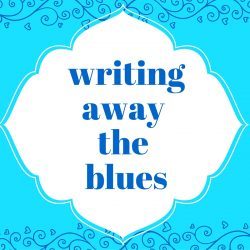
How The Author of A HOUSE FOR HAPPY MOTHERS Wrote Away Her Blues
by Amulya Malladi
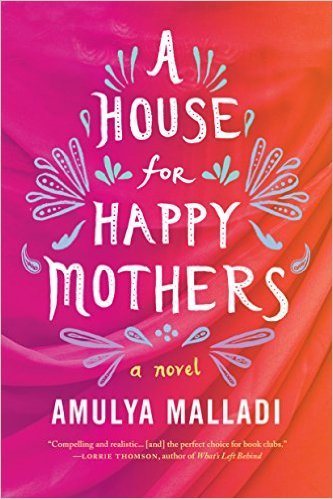 A few years ago, I became sad.
A few years ago, I became sad.
I stopped writing. This was no ordinary writer’s block; this was writer’s block stemming from having no feelings at all, an entirely different thing. I didn’t care much that I didn’t write. I was so miserable at my marketing day job that I had become indifferent to it. My marriage was not tip-top either because I hadn’t told my husband I was sad. I was faking it at home but invariably the cracks were showing.
I started writing when I was 11 years old. I can now look back and see that I started to write stories as a way to step away from real life into a fantasy world. I became an author to get away from a difficult childhood – and not because a story beckoned me and asked for it to be told. This is a pattern I have repeated my whole life to the point that in my heart, I know that if there isn’t a story that I’m working on, then I am miserable – by definition.
But this sadness I experienced a few years ago was different. It was the big bad black – the real thing – the nasty.
Part of the reason that I didn’t reach out to the writer within me was because the writer had stopped believing. My fifth book came out in 2007 and after that no one would buy my next book – not until eight years later. I work fulltime as a marketing executive and writing is hard work, so I told myself why should I do it? It doesn’t make me happy – because I have to face rejection and I don’t really have the time, do I?
Even though I turned my back on the writer within me, the storyteller still reached out to me in the darkness to draw me out. I know it sounds dramatic but really, it happened just like that.
My life was a mess. I was having exaggerated responses to everything. I was losing my temper. I was not sleeping. I was not eating. I cried uncontrollably at the drop of a hat. My emotions were everywhere. I knew I had to do some things on many fronts. First, I knew I had to change jobs. This job was making me miserable. So I did that. Second, I worked on my personal life. I have a very nice husband so that turned out to be easier than I feared. And third, I had to go back to a story. This was the hardest of the three. The one I did last.
It happened slowly and then all of a sudden.
One morning I woke up, hoping this day would be better than the previous one, knowing fully well that it wouldn’t be. The world was painted gray around me after all. But on this day, I realized that it wasn’t entirely true anymore – there was color in my life again. I was feeling better from a work perspective. My personal life was healthy again.
I for some reason started to think about the second law of thermodynamics that states, “Entropy or disorder in a closed system will either remain the same or increase.” And what happens when disorder goes out of control? The system implodes. That’s what happened to me, I thought. I was the closed system and my disorder became out of control.
So this morning, the morning I found the colored patches on the gray fabric of my life – I started to tell the story of a woman who had imploded. It started that simply. I knew her name was Sanya. I knew she was Indian. I knew she was temporarily in Copenhagen. I knew that her marriage was on the rocks. I knew that everything around her was painted gray.
As I wrote, I discovered that I was not going to let neither my world nor Sanya’s remain gray – so I started to paint patches of color onto her and my gray canvas with broad comedic strokes. I started to laugh as I wrote Sanya’s story of finding herself in gray Copenhagen.
As a rule I always read out what I write on a given day to my husband – he’s my first audience. As I wrote the first chapters, we both started laughing. I didn’t think this book would sell. I had sincerely believed at the time my career as a writer was over. I wrote this story purely for my pleasure, to make me laugh – to make me happy. It certainly did. I was entertained and curious to go on this ride with my slightly crazy character and as she found herself, I found myself as well. This story became The Copenhagen Affair, which will be my seventh book, published by Amazon Lake Union in 2017.
 Amulya Malladi is not sad anymore – but living a full and colorful life in Copenhagen in Denmark where she lives with her husband and two sons. During her spare time she works fulltime as a marketing executive for a medical device company. Her latest book A House for Happy Mothers has just been released. You’re welcome to add color to her life by reading and reviewing her new book and by becoming part of her Facebook family or signing up for her newsletter at www.amulyamalladi.com.
Amulya Malladi is not sad anymore – but living a full and colorful life in Copenhagen in Denmark where she lives with her husband and two sons. During her spare time she works fulltime as a marketing executive for a medical device company. Her latest book A House for Happy Mothers has just been released. You’re welcome to add color to her life by reading and reviewing her new book and by becoming part of her Facebook family or signing up for her newsletter at www.amulyamalladi.com.
Website | Facebook | Twitter | Art

June 5, 2016
The Writing Life #10
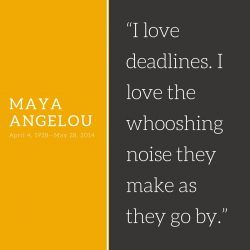
Just kidding. I don’t miss deadlines. But, this week I made great strides toward that July 25th deadline of mine, as I cut macerated edited rewrote transformed two pages of some important back story into—wait for it—a half page. This wasn’t easy, my friends. I had beta readers sad that the plan was to remove this flashback of Teddi’s. They loved it. I loved it. My challenge then, was to work it into the story in a more seamless fashion without losing the true meaning and some of the details.
No hocus pocus involved. This was manual labor.
And I love how it works, sounds, and feels.
I used something less like an ax and more like a scalpel. Or maybe it was like seeing the finished sculpture in the slap of marble. It was all there, I just had to chip away at the raw material to get to the end result. Use which ever image works for you.
I’ll be doing this again as I edit Left To Chance, and since I enjoy seeing old things in new ways, this is fun for me. It’s like turning the story upside down in order to be able to imagine it another way — because I’ve been writing it and thinking about it a certain way since last year.
This is just one way of killing one of our darlings, isn’t it? That’s not always about axing a character, or a plotline. Killing our darlings can be as simple and as complex as deleting our own words that don’t belong, whether it’s purple prose or dialogue tags or too much back story (who me?).
Speaking of dialogue (so punny am I!), if you missed my guest post on Writers In The Storm, it’s all about how I write and edit dialogue to make sure it serves the story and the reader. You’ll find out my dialogue tag theory (which is no, no, please don’t)! So, check it out and join the dialogue on dialogue ! (Did I mention I was awake at 4am today? It’s only going to get worse.)
Of course, just after I sent off the post, I came across a “she commanded,” while I was editing Left To Chance.
Which is the whole point of editing, isn’t it?
***
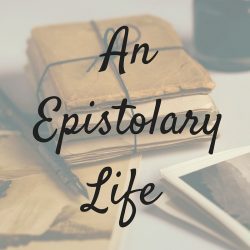
I’m a morning reader, and right now I’m lucky to be reading a early copy of ALL THE BEST PEOPLE by Sonja Yoerg which comes out in May 2017. You’re not going to want to miss this one, folks. The writing is just beautiful and the story — well — I’m not finished yet but the characters are compelling and I can’t wait to see what happens next. And right now, that’s all I need!
In addition to reading, I’m also listening to the audio book THE READERS OF BROKEN WHEEL RECOMMEND. I listen to books when I exercise, clean, and fold laundry. All of the things I don’t like to do accompanied by one of the things I like to do best! I’ve only just started but I am enjoying the narrator, the unusual story line and the epistolary component to the book.
A few of my favorite epistolary novels:
LETTERS FROM SKYE by Jessica Brockmole (Sweeping historical fiction. A love story with vibrant prose!)
ELLA MINNOW PEA by Mark Dunn (The most creative and clever book I’ve ever read!)
GUERNSEY LITERARY AND POTATO PEEL PIE SOCIETY by Annie Barrows and Mary Ann Shaffer (The title should be enough, but there’s more!)
One day, when I can learn to say it, and then to spell it without spellcheck, I too, will write an epistolary novel.
Truth be told, I’ve lived an epistolary life (spelled it that time ON MY OWN, FOLKS) as I’ve had a penpal, Carol, since I was nine. You can read about it in the Chicago Tribune. The column was published nine years ago, but when you’ve been friends with someone for forty-three years, that’s nothing! Now, sometimes we’ll write three times a day and then many not again for three months. Sending photos is easier than ever it ever was. No extra airmail stamps!
To harness the idea of an epistolary novel, or even an element, I think I’ll just have to dig into my memory of the letters with Carol. I’m sorry I didn’t save them. The letters took time to compose, mail, and then to arrive, yet somehow it seems as if the first words were always “And then…” instead of Dear Carol or Dear Amy. We somehow picked up where we’d left off, even if much had happened in the interim. Our stories had no gaps, and we then had a shared story as well.
Not all penpal stories have happy endings, of course. Remember Big Blue Marble? I was matched with Cinderella Fu from China. She never wrote back.
Must’ve been the stepmother’s fault.
***
Two guest posts from award-winning women’s fiction authors this week: Amulya Malladi, author of A House For Happy Mothers and Amy Impellizziri, author of Lemongrass Hope!
Did you know you can follow me on Instagram? Because MITZI. (Click the camera-looking link in the upper left sidebar.)


If you’ve read The Good Neighbor, did you love Mrs. Feldman? Do you want a peek into Mrs. Feldman’s life? Leave your email address below, or email me, or send me a FB message or a Tweet, and I’ll send you a photo relevant to her special back story!
If you haven’t read The Good Neighbor, just let me know when you do! You won’t find any spoilers here, friends!
More next week on the writing life!
Til then,
Amy xo

June 1, 2016
Guest Post: On Writing To Trends by Tina Ann Forkner
This is what I think of when I think of trends. Hurry up and wait. Hurry up and write to a trend and then wait for that trend to die. We can all get caught up in it, but if it’s not what you’d be writing without the trend, chances are, it’s not the right writing for you. At least not long term. Okay, at least not for me. I had an agent ask me if I’d consider writing suspense. (Had this person read anything I’d written? Yes. So this clearly was not a match.) I said yes, meant no, and nothing went any farther than that. I can’t write to trends, although I can take what’s popular now into account when I’m writing a book that will come out THREE YEARS FROM NOW.
So, my friends, writing to trend might be a little more like a dog trying to catch its tail than we’d like to admit.
And like my dear friend, Tina Ann Forkner says, perhaps we should focus on being the ones who set the trends.
I’m with her.
How do you feel about today’s trends in women’s fiction and how do you feel about writing to trend?
Welcome Tina back to WFW, and let us know your thoughts in the comments!
Amy xo

Setting Your Own Trend in Fiction
By Tina Ann Forkner
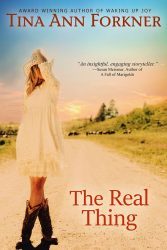 Over the years I’ve seen a lot of writing trends. If you’re a reader or a writer, you’ve no doubt noticed them too. A book about a particular topic becomes a bestseller and almost overnight a bumper crop of similar themed books pops up out of nowhere. As a writer, it frustrates me because I know some of those copycat books are going to sell loads of copies, but truth be told, most won’t. Instead of trying to write to a trend, why not write a novel that is completely original?
Over the years I’ve seen a lot of writing trends. If you’re a reader or a writer, you’ve no doubt noticed them too. A book about a particular topic becomes a bestseller and almost overnight a bumper crop of similar themed books pops up out of nowhere. As a writer, it frustrates me because I know some of those copycat books are going to sell loads of copies, but truth be told, most won’t. Instead of trying to write to a trend, why not write a novel that is completely original?
I’m not saying that every book with a shared theme falls into the copycat category. There are plenty of books that were already written before one like it took off and will be written after, but have a completely different spin on the theme. If the authors of those books are lucky, they will benefit from the comparison. That’s the best kind of luck an author can have and we should all be so lucky, but that sort book publishing magic can’t be manufactured.
Writing to a trend is always a perilous undertaking. By the time an author finishes her story and manages to get it published, the theme’s popularity might disappear, leaving the author with hours of wasted creative time. There is also a mad rush associated with writing to a trend that could produce poor writing, so it’s best to avoid the whole thing unless you have unlimited time. If you’re really a writer, or if you’re human, you don’t have time to waste, so why are writers tempted?
I have to admit that sometimes I’m tempted to jump on a bandwagon too, especially when I write about something that isn’t very popular. When I created a stepmom character in my latest novel, chose to do so because the topic of blended families was, and is still, close to my heart. In fact, I’m a stepmom, so the book is probably as close to my personal life as anything I’ve ever written, but in case you haven’t heard, being a stepmom isn’t all that trendy in fiction. I’ve never seen a call for proposals on stepmoms.
Obviously, I didn’t decide to write about Manda, a brand new stepmom, because stepmoms are the latest trend. In fact, no matter how many stepmoms are out there and despite movies like Stepdad and Blended, stepfamily novels have never really been all the buzz. Just look around you. The stepparents are almost always bad in literature. For all I knew, publishers might have preferred I wrote to the trend of evil stepparents. Good stepmoms in storytelling are usually evil, incompetent, or just plain silly. Just look at Snow White’s stepmom. Not a nice lady, but very popular.
I assure you that as a stepmom, I’ve never considered banishing my children to the woods, only the time-out chair. If my theme of a complicated love story between a man, woman, and their blended family doesn’t help the portrayal of positive stepfamilies become a trend in fiction, I’m still glad I wrote it. So, next time you’re trying to figure out what to write, forget about the latest trend. What stirs YOU? Because whatever stirs you up, might also stir the hearts of readers. That’s the kind of trend you want to write for.
 Tina Ann Forkner is the author of four novels including The Real Thing, a novel about a woman who marries her dream cowboy and becomes the stepmother of his children only to discover that being a stepmom is almost as difficult, and rewarding, as being a rodeo cowboy’s wife. Her novel Waking Up Joy was a 2015 HOLT Medallion Award of Merit Recipient for Romantic Elements and she is a member of Tall Poppy Writers. Tina lives in Wyoming with her husband and their three children. Learn more at www.tinaannforkner.com
Tina Ann Forkner is the author of four novels including The Real Thing, a novel about a woman who marries her dream cowboy and becomes the stepmother of his children only to discover that being a stepmom is almost as difficult, and rewarding, as being a rodeo cowboy’s wife. Her novel Waking Up Joy was a 2015 HOLT Medallion Award of Merit Recipient for Romantic Elements and she is a member of Tall Poppy Writers. Tina lives in Wyoming with her husband and their three children. Learn more at www.tinaannforkner.com

Women's Fiction Writers
- Amy Sue Nathan's profile
- 543 followers



